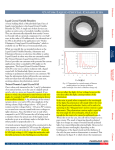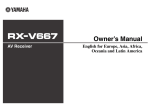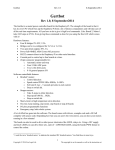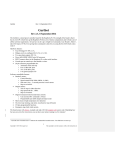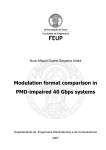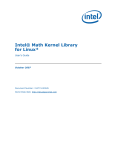Download BTO BLAS User Manual
Transcript
The Build to Order BLAS User Manual
by Geoffrey Belter, Ian Karlin, Jeremy G. Siek, Thomas Nelson
and E.R. Jessup
University of Colorado at Boulder
1. Introduction
The Build to Order (BTO) BLAS compiler takes as input a file specifying a
sequence of matrix and vector operations, and creates an implementation
in the C language tuned for memory efficiency. The implementation may
be serial or parallel using PThreads on shared memory systems. All loop
fusion opportunities are enumerated in order to decrease memory traffic.
The compiler employs a combination of analytic modeling and empirical
testing to quickly make optimization choices and ultimately produce the
most memory-efficient subroutine version for the hardware on which the
compiler is run.
2. Installation Instructions
Currently, BTO is UNIX-specific because it relies on the gettimeofday()
function for timing. The compiler has been used and extensively tested on
both Linux and Mac OSX systems.
1. Download the BTO BLAS distribution file bto.tar.gz.
2. Uncompress and un-archive the distribution file with
tar zxvf bto.tar.gz
3. To compile BTO BLAS, type ./install.shin the btodirectory. This
creates an executable named btoblasin the binsubdirectory. The
installation process may take a few minutes; benchmarks are run to
determine characteristics of the machine where the compiler will
operate. BTO BLAS may make optimization choices based on its
machine-specific environment.
3. Creating an Input File
Input to the compiler is a .mkernel file including input and output
parameters and a sequence of linear algebra operations. These operations
are written using the matrix arithmetic syntax of MATLAB. Several such
files can be found in the bto/matlabKernelssubdirectory. Below is an
example kernel.
BICGK
in
A : matrix(orientation=column), p :
vector(orientation=column), r : vector(orientation=column)
out
q : vector(orientation=column), s :
vector(corientation=olumn)
{
q = A * p
s = A' * r
}
The first line of the kernel is its filename. Next is a list of parameters
organized into three sections: in, inout, and out.Each of the three
sections is optional. Each section is a list of parameters and their types
separated by commas. The inoutsection contains parameters that are
both read from and written to during the computation.
Parameters can have the following types: matrix, vectorand scalar.
For matrix and vector types, specify whether the orientation is rowor
column.
The matrix arithmetic section, in curly braces, consists of a sequence of
assignment statements. Expressions follow MATLAB conventions.
- A' indicates AT
- * indicates multiplication
- = indicates assignment from the right-side expression or variable's
value to the left-side variable
3.1 Restrictions and Common Errors
Addition and subtraction require both operands to be of the same type and
have the same (row or column) orientation. For example, addition of two
row-major matrices is possible, but not addition of a row matrix and a
column matrix. Likewise, addition of two column vectors is allowed, but
adding a column vector and a row vector is not. The result's type must
match the operand types.
For example, the result of subtracting two column-major matrices is a
column matrix, not a row matrix. If these conditions are not satisfied, the
compiler exits with an error.
The rules of matrix computation concerning multiplication apply here. Let
A, B, and C be some arbitrary matrices, and c, d, e scalars.
c=d*e
c = row vector * column vector
column vector = column vector * column vector
A=B*C
column vector = A * column vector
Matrix-matrix multiply will take any combination of orientations so, for
example, multiplying a row-major matrix by a column-major matrix
produces a column-major matrix.
The following is an example of a combination that does not make sense
according to matrix math rules. The operand dimensions are mismatched.
That is, a column vector has dimension (n x 1). If, for example, the
computation (n x 1) * (n x 1) is entered, the two inner dimensions, 1 and
n, do not match, so the multiplication will not be performed.
Multiplying (n x 1) * (1 x n) or (1 x n) * (n x 1) works because the inner
dimensions n and n, or 1 and 1, match.
4. Running the Compiler
To run the compiler type ./bin/btoblas matlabKernels/inputfile.m
in the bto directory. The compiler takes one mandatory argument as its
input, a linear algebra kernel .m file, as described in Section 3. The output
will have the same name as the input file, but with suffix .c. It contains
what the compiler's algorithm considers the most efficient C-language
version of the kernel. Output lands in the input file's directory location.
Optional arguments to btoblasare described below.
4.1 Options
-h [ --help ]
Will bring up a help menu with the
below options.
-a [ --precision ]
precision
Set the precision type for scalars in
the generated output (float or
double). The default is double.
-t [ --threshold ]
fraction
This parameter controls how much
empirical testing is performed. Only
used with use_model on.
-m [--use_model] Enable the analytic model when
testing kernels. If set the compiler
will use a memory model to help
with optimization choices. Not
recommended for most users.
-e
[--empirical_off]
Disable empirical testing. Empirical
testing is enabled by default. When
empirical testing is disabled, best
performance is decided only by
analytic model. Disabling the model
and empirical testing will generate
many versions, but will not attempt
to determine the best performing.
-c [--correctness] Enable correctness testing.
Correctness testing is disabled by
default. When enabled, the input
program is converted to a set of
very naive BLAS calls which BTO
results are compared to. This
requires having and working BLAS
with cblas entry points. See
"Correctness Testing" section for
further details.
-r [--test_param] Set parameters for empirical and
start:stop:step
correctness testing as:
a:b:n
This directs the tests to use matrix
order and vector sizes between start
and stop values of a and b using a
step size of n. See "Testing" section
for additional details.
-b [--backend]
name
Select the code generator. Two C
code generators are currently
available. One generates C code
with pointers and the other
generates C code using
variable-length arrays (C99).
ptr
: generate pointer
code
noptr : generate VLA code
-s [--search]
Specify the search strategy. One of
search
[ga|ex|random|orthogonal|debug|th
read]
--ga_timelimit
arg (=10)
Number of seconds to run genetic
algorithm
4.2 Choosing BTO Option Flags
It is possible to create option combinations that generate unwanted
results. The default settings are for routines with operations that contain
O(N^2) data and calculations. For routines that contain less data and/or
fewer calculations, we suggest using the roption to increase the start
and stop values of the calculation modeled and tested. The default
start:stop:step is 3000:3000:1.
Turning off both empirical testing and the model using the eand mflags
results in the compiler being unable to determine which routine version is
best. Only one of these flags should be used at a time.
5. Calling the Generated Kernel
The output file consists of one function that implements the specified
linear algebra kernel. The name of the C function is the name specified in
the input file. The parameters of the C function correspond to the input
and output parameters in the following way. For each matrix parameter,
there are three parameters to the C function, a pointer to the first element
of the matrix, the two integers: the number of rows, and the number of
columns. For each vector parameter, there is a pointer to the first element
of the vector and an integer specifying vector size. Each matrix or vector
must be represented as a contiguous block of memory. The following is the
function declaration for the BiCGK kernel given in Section 3.
void BICGK(double* A, int A_nrows, int A_ncols,
double* p, int p_nrows,
double* r, int r_nrows,
double* q, int q_nrows,
double* s, int s_nrows);
Some of the size parameters are redundant. For example, in this kernel,
the p_nrowsparameter should have the same value as A_ncolsbecause
the kernel multiplies matrix Aby vector p. In a future release, the
parameter list for the generated function will be more concise. The
following is a simple example use of the above BiCGKfunction.
#include <stdio.h>
void BICGK(double* A, int A_nrows, int A_ncols, double* p,
int p_nrows, double* r, int r_nrows, double* q, int q_nrows,
double* s, int s_nrows);
int main(int argc, char* argv[])
{
double A[] = { 1, 1, 1,
1, 1, 1,
1, 1, 1 };
int m = 3;
int n = 3;
double p[] = { 1, 2, 3 };
double r[] = { 4, 5, 6 };
double q[] = { 0, 0, 0};
double s[] = { 0, 0, 0};
int i;
BICGK(A, m, n, p, n, r, m, q, m, s, n);
printf("q: ");
for (i = 0; i != m; ++i)
printf("%f ", q[i]);
printf("\n");
printf("s: ");
for (i = 0; i != n; ++i)
printf("%f ", s[i]);
printf("\n");
}
The output of this example is
q: 6.000000 6.000000 6.000000
s: 15.000000 15.000000 15.000000
6. Testing
BTO BLAS has an empirical tester which measures execution time using
gettimeofday(), and a correctness tester which can be enabled to verify
generated code. The empirical tester is enabled by default and assists in
the process of identifying the best set of optimizations. The correctness
tester is disabled by default, but may be enabled with the command line
flag c.
Both of these tests have a set of user-definable features including
compiler, compiler flags, libraries, and include paths. These values are set
in the file bto/make.inc. The 'compilers' and 'flags' features are shared
by both tests. These are set in make.incas TCCand TFLAGS. Any other
compilation command line flags specific to either test can be set using
CORRECT_INCor EMPIRIC_INC.
Sizes used in these testers is set for each run of BTO using the rflag.
This flag requires start:stop:step to be specified. The use of these sizes
is explained in the following subsections for each type of test.
6.1 Empirical Testing
Empirical testing is enabled by default. This test can be disabled using
the command line flag e.
Beyond the compilation controls found in make.inc, a user should specify
appropriate size information using the rflag. The default start:stop:step
for the r flag is 3000:3000:1, which which will empirically test using
square matrices of order 3000 and vectors of size 3000. The default
setting will give valid empirical times for many matrix-vector operations,
but may not be large enough to result in a 'good' BTO-BLAS run for certain
vector-vector operations, or very powerful machines. In a case like this,
simply increase the start and stop values.
Currently, the empirical tester only handles square matrices. All vector
sizes and matrix orders are the same. The empirical tester uses the
largest available size for determining best performance. For example if r
500:1000:500is specified, the empirical test will be run for sizes of 500
and 1000, but only the performance from 1000 will be used. For
compilation speed it would be better to use r 1000:1000:1.
The empirical tester is available in a temporary working directory. If BTO
BLAS has run on the kernel PATH/bicg.m, the empirical tester is located in
the subdirectory PATH/bicg_tmp/bicgETester.c .
6.2 Correctness Testing
Correctness testing is disabled by default. This test can be enabled using
the command line flag c. Enabling this test requires that a BLAS library
with cblas entry points be included in bto/make.incusing CORRECT_INC.
If a publicly available BLAS is present on a machine, it is likely that the
following will work.
CORRECT_INC = I./ lblas
(In some cases cblas must be specified explicitly)
CORRECT_INC = I./ lcblas lblas
(If BLAS is located in the user's home directory)
CORRECT_INC = I./ L$(HOME)/BLAS/ lcblas lblas
The input program is converted to naive cblas calls. The sequence of calls
is not an ideal use of BLAS, and performance comparison against the
correctness tester would not be a fair comparison to BLAS.
When the correctness tester is turned on, it only analyzes what the
empirical tester would otherwise. This can be controlled using the tflag.
Setting t 1will test all versions produced. If tis not used, model
settings and differences in input programs will determine what is sent to
the correctness tester.
Beyond the settings in make.inc, the user should specify appropriate size
information using the rflag. The correctness tester will look at sizes
within the specified range, including rectangular matrices. The following is
an example call to BTO.
./bin/btoblas matlabKernels/bicg.m t1 c r 25:100:25
This will test all versions produced for the kernel bicg.m, using
combinations of the sizes 25, 50, 75, and 100. The combinations are
determined based on what the input program is. Given a simple input
such as this which performs one computation, adding two matrices, there
will be two common sizes, M and N. The test generator will look like the
following.
for (M = 25; M <= 100; M += 25)
for (N = 25; N <= 100; N += 25)
perform test
The correctness tester is available in a temporary working directory. If
PATH_TO_KERNEL/bicg.mhas been run, the correctness tester
bicgCTester.cfor the kernel bicg.mlives in the subdirectory
PATH_TO_KERNEL/bicg_tmp.
7. Further Information
Publications concerning BTO BLAS are available on our website
ecee.colorado.edu/wpmu/btoblas/. If you wish to cite our work or are
looking for a more detailed explanation of some aspect of it, the following
papers are a relatively recent and comprehensive overview of the project.
Details about the serial compiler, model and how the two interact:
Geoffrey Belter, Ian Karlin, Elizabeth Jessup, Jeremy Siek. Automating the
Generation of Composed Linear Algebra Kernels[pdf]. In SC09: the
International Conference on High Performance Computing, Networking,
Storage, and Analysis. November, 2009.
Information concerning parallel code generation:
G. Belter, J. G. Siek, I. Karlin and E. R. Jessup. Automatic Generation of
Tiled and Parallel Linear Algebra Routines: A partitioning framework
for the BTO Compiler. In the Fifth International Workshop on Automatic
Performance Tuning (iWAPT‘10), Berkeley, CA, June 2010, pp. 1-15.
Information on the parallel memory model:
I. Karlin, E. R. Jessup, G. Belter and J. G. Siek. Parallel Memory
Prediction for Fused Linear Algebra Routines. In the 1st International
Workshop on Performance Modeling, Benchmarking and Simulation of High
Performance Computing Systems (PBMS 10), New Orleans, LA, November
2010, pp. 1-8.
Appendix
A. Syntax and Grammar
The syntax for parameters is given by the following grammar.
NAME = [aZ][aZ09]*
orientation ::= "row" | "column"
type ::= "scalar" | "matrix(" orientation ")" | "vector("
orientation ")"
parameter ::= NAME ":" type
parameter_list ::= parameter | parameter "," parameter_list
The specifications for matrix arithmetic are enclosed in braces and consist
of a sequence of assignment statements. Expressions follow MATLAB
conventions with ' for transpose, * for multiplication, and the variable on
the left side of the equal sign (=) is assigned the result of the calculation
on the right side. The grammar for the subset of MATLAB employed by
BTO matrix kernels is shown below.
NUM = [09]+
body ::= "{" stmt* "}"
stmt ::= NAME "=" expr
expr ::= NUM | NAME
| expr "+" expr
| expr "" expr | expr "*" expr
| "" expr
| expr "'"
| "(" expr ")" The grammar for the entire input file is as follows.
file ::= NAME ["in" parameter_list] ["inout" parameter_list]
["out" parameter_list] body












